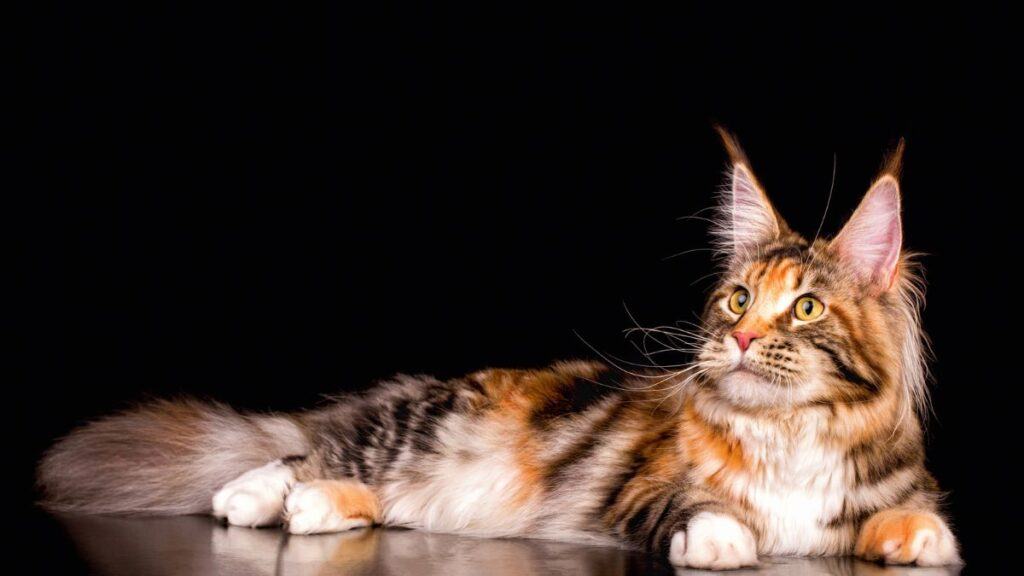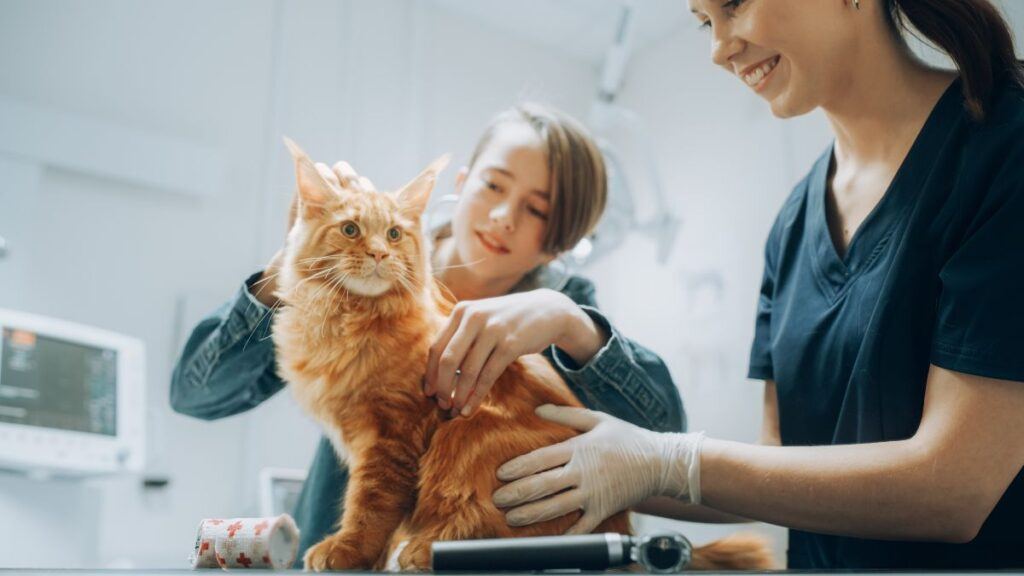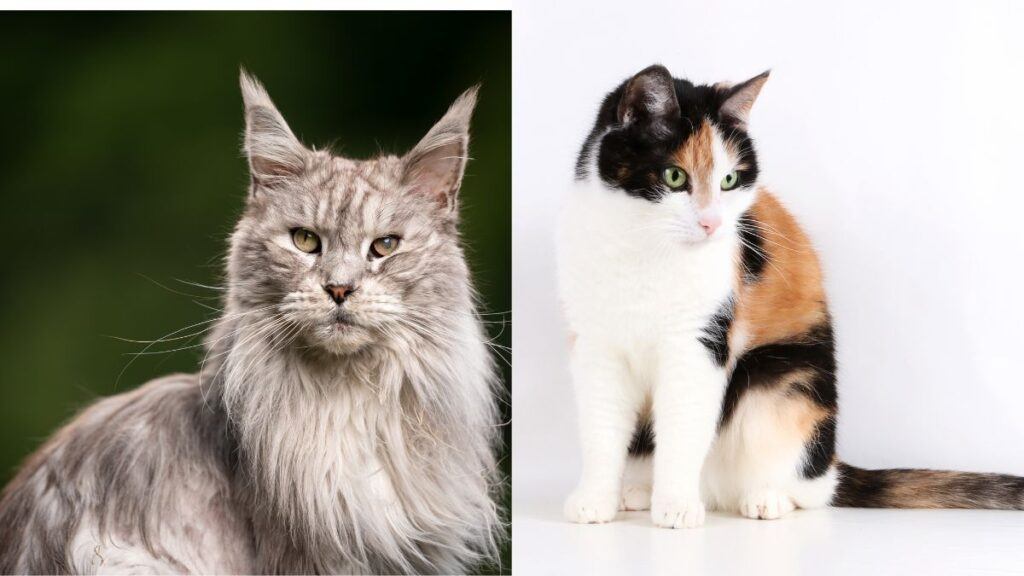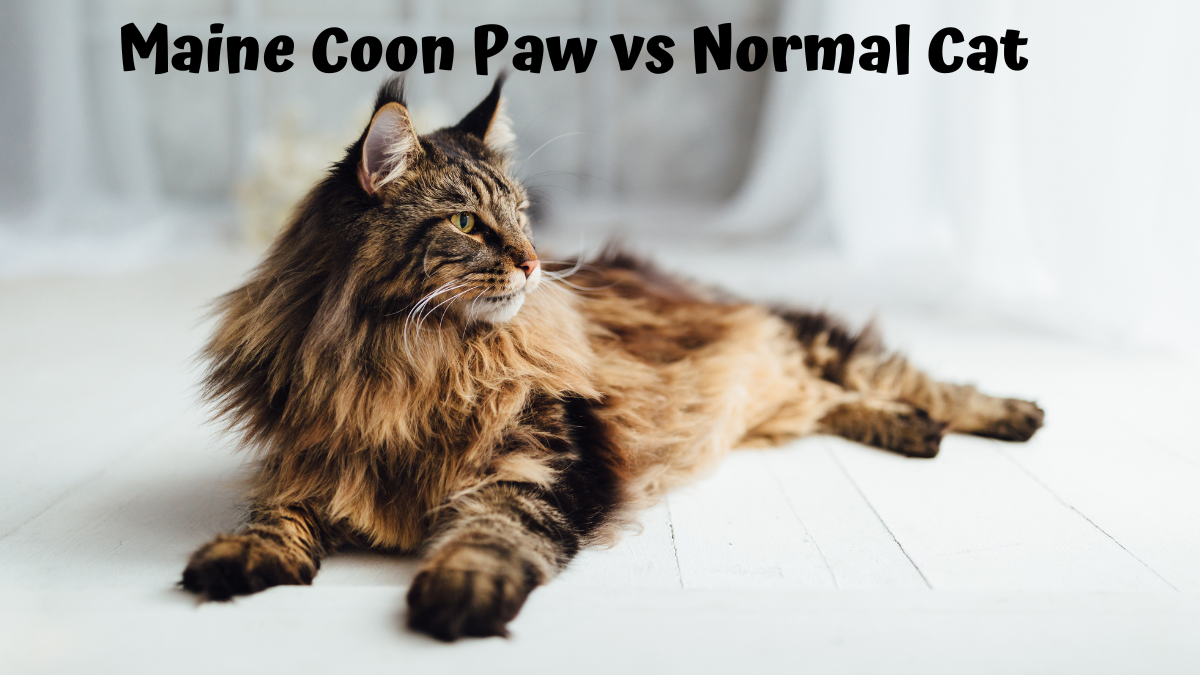Embark on an enchanting journey into the majestic realm of Maine Coon cats with our comprehensive guide, “Maine Coon Paw vs Normal Cat: Distinguishing Features Unveiled.”
Celebrated for their luxuriant shaggy coat and impressive stature, Maine Coons are a breed apart from your average domestic feline.
Our in-depth analysis sheds light on the unique characteristics of Maine Coon paws, setting them apart from those of their normal-sized counterparts.
You will learn about the nuances of paw size, intricate bone structure, and the captivating phenomenon of polydactylism that frequently graces this gentle giant of the cat world.
Physical Characteristics of Maine Coon Paws

The Maine Coon’s paws are distinctive not only for their size but also for their unique features and potential for polydactylism, which contribute to the breed’s well-known prowess for hunting and adaptability in snowy environments.
Size Comparison With Normal Cat Paws
Maine Coon paws are significantly larger than those of the average domestic cat. This considerable size difference is due to the Maine Coon’s larger overall body size.
A comparison of paw size demonstrates the Maine Coon’s big paws:
| FeatureMaine Coon PawsNormal Cat Paws | ||
|---|---|---|
| Width | Up to 1.5 inches | Under 1 inch |
| Length | Up to 2 inches | 1 to 1.5 inches |
| Toe Count (Typical) | 5 toes | Five toes (uncommon) |
| Toe Count (Polydactyl) | Up to 7 toes | Five toes |
| Surface Area | Larger for better weight distribution | Smaller, Less spread out |
Unique Features of Maine Coon Paws
Maine Coon paws have several physical features that distinguish them from other breeds. These include:
- Extra toes: It’s not uncommon for Maine Coons to be polydactyl, a genetic trait that results in more than the usual number of toes.
- Tufted Fur: The paws often feature tufts of fur that protrude from between their toes, aiding in protection against cold weather.
- Shape: The paws are broad and rectangular, providing a stable base for their large bodies.
Paw Pad Health
Maine Coon paw pads are typically thick and cushioned, aiding in their ability to absorb shock when they walk or leap.
A healthy paw pad should be smooth and free of cracks or lesions. Common health considerations for Maine Coon paw pads include:
- Inspecting for cuts, thorns, or other foreign objects that could embed in the large pad area.
- Monitoring for signs of infection or inflammation, especially in cats with a higher number of toes, as this can sometimes cause complications.
General Attributes of Maine Coons

Maine Coon cats are well-known for their impressive size, unique fur texture, and distinctive markings.
These characteristics set them apart from other feline breeds, making them remarkable and recognizable cats.
Size and Stature
Maine Coons are notable for their large size and massive stature.
They are one of the largest domesticated cat breeds, with males on average weighing between 13 to 18 pounds and females between 8 to 12 pounds.
The Maine Coon’s size is complemented by their muscular build, giving them a strong and rugged appearance.
- Height: 10-16 inches
- Length: Up to 40 inches, including the tail
- Weight: 8-18 pounds (females); 13-25 pounds (males)
Coat and Fur Texture
The coat of a Maine Coon is heavy and shaggy, particularly around the neck, where it forms a distinctive ruff.
Maine Coon coats are water-resistant and consist of a soft undercoat beneath a layer of longer, thicker guard hairs.
This combination provides insulation and requires regular grooming to maintain its long hair without matting.
- Outer Coat: Long, coarse, and water-repellent
- Undercoat: Soft and fine for insulation
Distinctive Maine Coon Colors and Markings
Maine Coon cats boast a variety of distinctive colors and markings. While they can come in almost any color and pattern, some of the most common are brown tabby and tiger-striped.
Their physical characteristics often include tufted ears, a bushy tail, and lynx-like ear tufts, accentuating their wild appearance.
- Colors: Wide range, including solid, tabby, tortoiseshell, and more
- Markings: Often feature ‘M’ shaped marking on forehead
Health Considerations for Maine Coons

Maine Coons are known for their majestic size and friendly demeanor; however, they come with distinct health considerations.
Owners need to be aware of potential genetic conditions, the necessity of regular health monitoring, and the grooming and care required to keep them healthy.
Common Genetic Conditions
Maine Coons may be predisposed to certain genetic health issues. Notably, they can be prone to Hypertrophic Cardiomyopathy (HCM), a serious heart condition characterized by the thickening of the heart muscle.
Early detection through genetic testing can be crucial. Hip Dysplasia, a developmental disease that affects the hip joints, can also be observed in this breed, potentially leading to mobility challenges.
They may also face a risk for Spinal Muscular Atrophy (SMA), a genetic disorder that causes muscle atrophy and weakness, though it does not typically affect the cat’s lifespan.
Regular Health Monitoring
To ensure the well-being of a Maine Coon, regular veterinary check-ups are necessary. These visits should include:
- Comprehensive physical examinations to catch any early signs of health problems.
- Routine screening for HCM, as this condition can develop over time even if initial genetic tests are clear.
- Monitoring for symptoms of hip dysplasia, mainly if the cat exhibits signs of lameness or discomfort.
Grooming and Care
Maine Coons sport a beautiful long coat that requires extra attention to maintain its condition. Here are key grooming tips:
- Weekly brushing is essential to prevent matting and reduce hairballs.
- Attention to the undercoat helps to remove loose fur and distribute natural skin oils.
Grooming sessions also offer a chance to check for any abnormalities or signs of health problems, such as lumps, bumps, or skin issues.
Regular care ensures not just a healthy coat but also promotes overall good health in Maine Coons.
Comparative Analysis of Maine Coon and Normal Cat Traits

The physical and behavioral distinctions between Maine Coon cats and other domestic cat breeds are significant, providing insight into how they may fit into a family setting as gentle giants or as average-sized feline companions.
Physical Feature Variations
Maine Coon Cats:
- Size: They are one of the largest domesticated cat breeds, with males weighing between 13 to 18 pounds and sometimes more, while females tend to be slightly smaller.
- Paws: Their paws are large, tufted, and well-adapted for their original outdoor lifestyle in the Northeastern United States, helping them traverse snowy environments.
- Coat: They sport a thick, water-resistant coat that is longer on the stomach and flanks, providing insulation against harsh weather.
Normal Domestic Cats:
- Size: An average cat usually weighs between 8 to 10 pounds, which is considerably less than a Maine Coon.
- Paws: Regular cats have proportionately smaller paws without tufts of fur between the toes.
- Coat: While coat length can vary among domestic cats, they generally have shorter coats compared to the Maine Coon’s luxurious fur.
Behavior and Temperament Contrasts
Maine Coon Cats:
- Demeanor: They are known for their friendly, gentle nature and are often called “gentle giants.” Even Maine Coon kittens show a patient and tolerant disposition.
- Interactions: They tend to be sociable with family members and are good with children and other pets, displaying dog-like characteristics such as loyalty.
Normal Domestic Cats:
- Demeanor: The temperament of average cats varies widely, but they tend to be more independent than Maine Coons.
- Interactions: Regular cats may or may not seek constant interaction, with some enjoying companionship while others are more aloof.
Maine Coon Historical and Cultural Significance
The Maine Coon is deeply embedded in American heritage, particularly in the New England region.
It is recognized for its distinctive physical characteristics and cultural impact, holding a place of pride as the official state cat of Maine.
Origins and Breed History
The Maine Coon breed, one of North America’s oldest natural breeds, shares a rich historical association with the state of Maine.
They are believed to have originated from mating between pre-existing short-haired domestic cats and longhaired breeds brought overseas by English seafarers or Vikings, which also led to comparisons with the Norwegian Forest Cat due to some similar traits.
Early records indicate that Maine Coons were widely recognized as proficient mousers, farm cats, and ship’s cats, integral to rural and seafaring life in New England.
Maine Coon in American Culture
Maine Coons have left their paw prints on American culture, with many being historically lauded for their mousing abilities and companionship.
As the official state cat of Maine, they symbolize a cherished aspect of local heritage.
Their amiable nature and hardiness linked them closely to the hardworking, resilient characteristics admired in the New England population.
Popularity and Breed Standards
In terms of recognition, the Maine Coon is one of the most popular cats in America, ranking as the fifth-most popular cat breed according to the Cat Fanciers’ Association.
The breed is characterized by its large size, tufted ears, bushy tail, and thick, water-resistant coat, which helped it endure the harsh winters of New England.
The breed standards set by cat associations emphasize these features and their gentle and friendly temperament.
Despite the prevalence of purebreds, mixed-breed Maine Coons are also widely celebrated by cat enthusiasts.
Breeding and Ownership Considerations
When choosing to bring a Maine Coon into one’s home, prospective owners should understand the importance of selecting a reputable breeder and be ready for the responsibilities that come with owning this distinctive breed.
A safe environment is crucial for the well-being of these large, sociable cats.
Choosing a Reputable Breeder
It is crucial for individuals interested in adopting a Maine Coon to research and select a reputable breeder thoroughly.
This can help ensure that the cats come from a lineage of careful and selective breeding, which aims to maintain the breed’s health, temperament, and distinctive characteristics.
- Check for breeder credentials and testimonials.
- Ensure health clearances and genetic testing of the parents.
The Responsibilities of Owning a Maine Coon
Maine Coon owners must be ready for a long-term commitment to their pet’s health and happiness.
These cats are among the most popular cat breeds, known for their friendly nature, and require regular grooming due to their long fur.
- Regular grooming: Weekly brushing to prevent matting.
- Healthcare: Routine vet check-ups and vaccinations.
Creating a Safe Environment
A safe environment is integral for the Maine Coon’s well-being. Owners should offer plenty of space for exercise and enrichment, as Maine Coons are large, active cats.
- Indoor space: Cat-proofed areas with plenty of vertical spaces for climbing.
- Outdoor access: Enclosed outdoor areas, if possible, to stimulate their curiosity safely.
Introducing Cory Haasnoot, a devoted father, loving husband, and enthusiastic cat lover. As a key content creator for CatFurLife.com, Cory blends his family values and passion for felines into engaging and informative content. He brings a unique perspective to the site, sharing cat care tips and how cats can enrich family life and bring joy to households.

